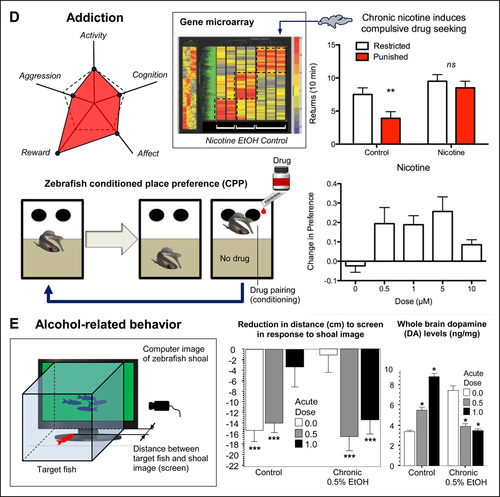|
Neurobehavioral phenotypes in zebrafish relevant to modeling a diverse group of psychiatric disorders (also see <xref rid='T1' ref-type='table'>Table 1</xref>)Axis represent five major phenotypic domains of brain disorders, and include motor activity, cognition, affect/emotionality, reward and aggression. A dashed- line pentagon represents ‘normal’ healthy phenotype for each respective axis/domains. Panel A shows typical zebrafish responses relevant to ADHD (modified from 125, 126). The bar diagram shows total distance swum in 5 min for control larvae and lphn3.1 morphants with and without methylphenidate (MPH) treatment. The right panel shows representative locomotion traces (recorded from the top view camera) in 6-dpf control and lphn3.1 morphant zebrafish (green color indicates swimming with normal speed, red color indicates bursts of ‘impulsive’ swimming with high-acceleration). Panel B illustrates zebrafish mirror-induced aggression (MIA) responses in the mirror exposure test, and typical patterns of zebrafish aggressive confrontations (modified from 139). Note that MIA is particularly simple to record and quantify161, making it also suitable for high-throughput screening (MIA images in the middle: courtesy of the Robison laboratory161, University of Idaho, USA). Panel C illustrates zebrafish stress- and PTSD-related aversive behaviors, including neophobia (e.g., acute 5-min exposure to the unfamiliar blue marble in the novel object test) and predator avoidance (acute 5-min exposure to a predator fish). Note that zebrafish avoid a blue marble at the bottom of the tank (swim traces in the open field test recorded by Noldus Ethovision XT8 from the top view), as well as display robust aversion of a live predator (e.g., Leaf fish), clearly spending more time in the opposite side of the tank. Panel D demonstrates zebrafish reward-related addiction behaviors (in the conditioned place preference model, CPP) and molecular alterations in zebrafish brain following exposure to a substance of abuse. In the CPP, fish are initially tested for their preference for both sides of the apparatus, each of which contains a discriminative stimulus (i.e., spots vs. no spots). They are then conditioned with drug to the least-preferred side over a number of sessions. Finally, their preference is assessed again in a probe trial, where the rewarding value of the drug can be ascertained by calculating the change in preference for the least-preferred side following conditioning (in addition to water immersion, also note the use of i.p. drug injections in some zebrafish CPP studies184, 190). The bottom right bar diagram also shows a classic dose-response curve for nicotine in adult fish (also note that mutant heterozygous for a nonsense mutation for the acetlycholinesterase gene (achesb55/+) do not show place preference for 6 µM nicotine; Brock et al., unpublished observations). Top right bar diagram shows fish that display persistent compulsive drug seeking (i.e., drug seeking despite adverse consequences/punishment) following chronic exposure to ethanol or nicotine, also demonstrating long-lasting drug-specific and conserved changes in gene expression197 (brain genes’ microarray, inset). Panel E shows the reduction in zebrafish social behavior (e.g., shorter distance between a test fish and moving shoaling images delivered on a computer screen; inset). This reduction in hoaling response is abolished by acute administration of a high concentration of alcohol, which was inactive in fish chronically pre-treated with alcohol. Withdrawal from alcohol chronic exposure also abolishes the shoaling response. Note that alcohol-induced behavioral changes in zebrafish are closely paralleled by alterations in DA levels quantified from whole brain samples using HPLC (modified from 203, 230).
|

